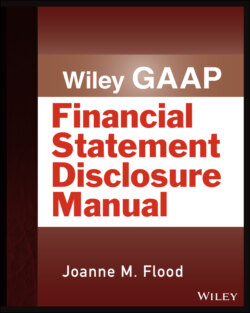Читать книгу Wiley GAAP: Financial Statement Disclosure Manual - Joanne M. Flood - Страница 117
Financial Instruments
ОглавлениеExample 7.21: Fair Value of Financial Instruments For certain of the Company's financial instruments, including cash and equivalents, restricted cash, accounts receivable, advances to suppliers, accounts payable, accrued liabilities and short‐term debt, the carrying amounts approximate their fair values due to their short maturities.
FASB ASC Topic 820, Fair Value Measurements and Disclosures, requires disclosure of the fair value of financial instruments held by the Company. FASB ASC Topic 825, Financial Instruments, defines fair value, and establishes a three‐level valuation hierarchy for disclosures of fair value measurement that enhances disclosure requirements for fair value measures. The carrying amounts reported in the consolidated balance sheets for receivables and current liabilities each qualify as financial instruments and are a reasonable estimate of their fair values because of the short period of time between the origination of such instruments and their expected realization and their current market rate of interest. The three levels of valuation hierarchy are defined as follows:
Level 1 inputs to the valuation methodology are quoted prices for identical assets or liabilities in active markets.
Level 2 inputs to the valuation methodology include quoted prices for similar assets and liabilities in active markets, quoted prices for identical or similar assets in inactive markets, and inputs that are observable for the asset or liability, either directly or indirectly, for substantially the full term of the financial instrument.
Level 3 inputs to the valuation methodology us one or more unobservable inputs which are significant to the fair value measurement.
The Company analyzes all financial instruments with features of both liabilities and equity under FASB ASC Topic 480, Distinguishing Liabilities from Equity, and FASB ASC Topic 815, Derivatives and Hedging.
As of August 31, 20X8 and 20X7, respectively, the Company did not identify any assets and liabilities required to be presented on the balance sheet at fair value.
Example 7.22: Derivative Financial Instruments The Company uses derivative financial instruments to manage its exposure to certain foreign currency exchange rate risks.
Net investment hedges. The Company enters into certain forward currency contracts that are designated as net investment hedges. The effective portions of the hedges are reported in accumulated other comprehensive income or loss, net of tax, and will subsequently be reclassified to net earnings in the period in which the hedged investment is either sold or substantially liquidated. Hedge effectiveness is measured using a method based on changes in forward exchange rates. The Company classifies the cash flows at settlement of its net investment hedges within investing activities in the consolidated statements of cash flows.
Derivatives not designated as hedging instruments. The Company also enters into certain forward currency contracts that are not designated as net investment hedges. They are designed to economically hedge the foreign exchange revaluation gains and losses of certain monetary assets and liabilities. The Company has not applied hedge accounting to these instruments and the change in fair value of these derivatives is recorded within selling, general and administrative expenses. The Company classifies the cash flows at settlement of its forward currency contracts which are not designated in hedging relationships within operating activities in the consolidated statements of cash flows.
The Company presents its derivative assets and derivative liabilities at their gross fair values within other prepaid expenses and other current assets and other current liabilities on the consolidated balance sheets. However, the Company's Master International Swap Dealers Association, Inc., Agreements and other similar arrangements allow net settlements under certain conditions.
The Company does not enter into derivative contracts for speculative or trading purposes. Additional information on the Company's derivative financial instruments is included in Notes 14 and 15 of these consolidated financial statements.
